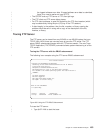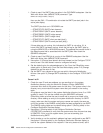
To obtain a copy of error messages written to the server job log, this subcommand
must be issued after the error has occurred. The user may then inspect the job log
using the WRKSPLF command.
This technique is recommended in those cases where the reply message returned
to the client from the server only provides minimal information about an error
occurring on the server machine. For example, this method is useful for obtaining
details about I/O errors that occur on the server machine.
If the error prevents the FTP server job log from being obtained by the method
described here, enter the following command to force a spooled job log to be
created for each FTP session:
CHGJOBD JOBD(QTCP/QTMFTPS) LOG(4 00 *SECLVL)
Then recreate the scenario which causes the error. To restore the original job log
behavior after obtaining the required data, enter the following command:
CHGJOBD JOBD(QTCP/QTMFTPS) LOG(4 00 *NOLOG)
Determining Problems for SMTP
SMTP is designed much the same as the other TCP/IP functions and applications.
Like TCP/IP or the FTP application, the SMTP jobs run under the QSYSWRK
subsystem and produce job logs with information associated with the SMTP jobs. If
the SMTP jobs end, the job logs can be used to determine the cause. If the mail is
not getting to the desired user, the job logs can contain information that helps with
the problem analysis.
The SMTP jobs do not start unless the QSYSWRK subsystem is running. SMTP
jobs will start if the QSNADS subsystem is not running. If you do not see
distributions on QSMTPQ when trying to send mail, ensure that the QSNADS
subsystem is running. Issue STRSBS QSNADS and ensure that the mail server
framework job QMSF is running in QSYSWRK by doing a STRMSF.
Notes:
1. You will only see mail queuing up on QSMTPQ, if the recipient’s System
Distribution Directory (SDD) entry points to the Bridge Client. The SDD entry
points to the Bridge Client if you have a Mail Service Level of ″User index″,a
Preferred address of ″User ID/Address″, and a System name of TCPIP.
2. POP3 Mail, or Domino mail will
never
be seen queuing on QSMTPQ, because
POP3 Mail and Domino mail go through the MSF framework. You will only see
distributions on QSMTPQ as it applies to mail from OV, or SNDDST.
Configuring an AS/400 system to use SMTP can be an extensive process. The
benefits of this extensive configuration are in the usability of the product. After
configuration, the use of SMTP is no different than any of the AS/400 mail
protocols. The user need not know whether the mail is being delivered by SNADS
to another SNA system, or by SMTP. A successful configuration should allow the
typical user to use the SMTP protocol without really needing to understand what is
going on in the background.
Problems with SMTP are usually associated with mail not being accepted by the
remote system or not being sent at all as shown in the following figure.
Chapter 21. TCP/IP Problem Analysis 457
|
|
|
|
|
|
|
|
|
|
|
|
|
|


















